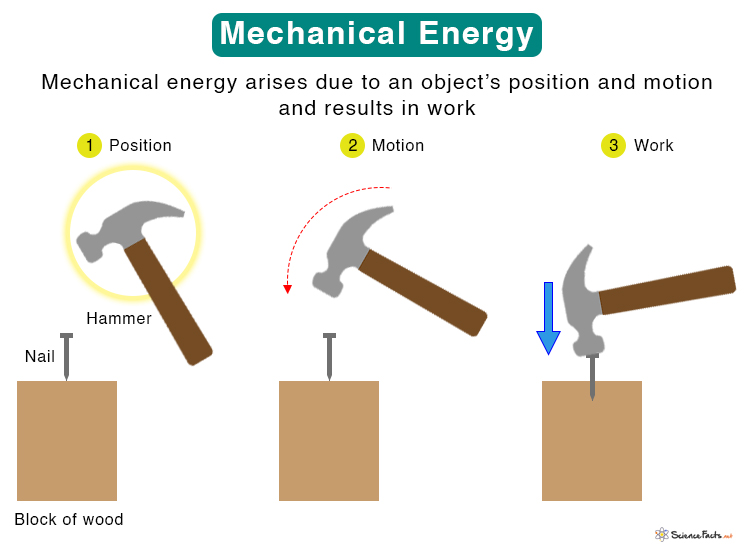Mechanical Energy
Mechanical energy is the energy of an object due to its position or motion. It is the basis of physics, as everything around us is driven by mechanical energy. From picking up objects to throwing them, mechanical energy can be seen in action every day. For example, an apple falling from a tree has mechanical energy.
An object possessing mechanical energy can do work by applying force. The change in mechanical energy is the work done. For example, when a bow is pulled, it stores energy. When released, the bow uses its stored energy and pushes the arrow to its trajectory. Thus, the bow works on the arrow at the expense of its mechanical energy. A bowling ball rolls on the alley and has mechanical energy. It does work by applying force and knocking down the pins.
Types of Mechanical Energy
There are two main types of mechanical energy.
1. Potential Energy: It is the energy stored in an object due to its position. Gravitational potential energy due to Earth’s gravity is a common type of potential energy. It depends on the object’s height from the Earth’s surface. For example, an apple in an apple tree has the maximum potential energy. When it falls, its potential energy reduces and becomes zero upon reaching the surface.
Apart from gravitational potential energy, other forms are elastic potential energy, electric potential energy, magnetic potential energy, and nuclear potential energy.
2. Kinetic Energy: It is the energy possessed by an object due to its motion. The movement of an object is manifested by its speed. Consider the above example. When the apple is in the tree, it is at rest with zero kinetic energy. When it falls, it gains speed owing to acceleration due to gravity. The kinetic energy increases and reaches a maximum when the apple hits the ground.
The types of kinetic energy are electrical energy, thermal energy, radiant energy, and sound energy.
Conservation of Mechanical Energy
According to the law of conservation of energy, energy can neither be created nor destroyed. It transforms from one form to another. In the above example, the potential energy of the apple transforms into kinetic energy. Therefore, the sum of potential and kinetic energy remains constant throughout its path. This sum is known as the total mechanical energy. The initial total mechanical energy is the same as the final total mechanical energy.
Mechanical energy is conserved only when the force acting on an object is conservative. A conservative force does not depend on the path taken to do work. On the other hand, non-conservative and dissipative forces depend on the path taken. In the apple example, gravitational potential energy acts on it, which is a conservative force. If non-conservative forces like friction or air resistance are present, the mechanical energy will get converted into heat energy. In this way, although the mechanical energy is not conserved, the total energy is conserved.
Examples of Mechanical Energy
- A book on a shelf has potential energy due to its height above the surface.
- A moving car possesses kinetic energy due to its motion.
- A baseball on its trajectory has potential energy due to its height and kinetic energy due to its speed.
- A weightlifter lifts a barbell above its head and gives it potential energy.
- A hammer gathers potential energy and transforms it into kinetic energy to hit a nail.
- A loaded dart gun has potential energy as the spring is compressed.
- A roller coaster moves on its track with kinetic energy. When it reaches its highest point, the kinetic energy is converted into potential energy. When it departs, the potential energy is converted back into kinetic energy.
- A swinging pendulum has both potential and kinetic energy. The potential energy is maximum when the pendulum is at two extreme points. The kinetic energy is maximum when it passes through the equilibrium point.
- A wrecking ball is a massive object with potential energy and kinetic energy. When it is swung to a high position, it has potential energy. When it is released, it gains kinetic energy.
Mechanical Energy Equations
How to Find Mechanical Energy
The total mechanical energy is defined as the sum of potential energy and kinetic energy.
1. Potential Energy
Suppose an object of mass m is at a height h above the surface of the Earth. Then, the potential energy can be found by the following equation.
P.E. = mgh
Where,
P.E. : Potential energy of the object
m : Mass of the object
g : The acceleration due to gravity
h : Height of the object
2. Kinetic Energy
Suppose the same object is moving with a velocity v. Then, the kinetic energy can be determined by the following equation.
K.E. = ½mv2
Where,
K.E. : Kinetic energy of the object
m : Mass of the object
v : Velocity of the object
Then, the formula for the total mechanical energy of the object is
Mechanical Energy = Potential Energy + Kinetic Energy
Or, M.E. = mgh + ½mv2
SI unit: J or Joule (1 J = 1 kg m2/s2)
Cgs unit: erg (107 erg = 1 J)
Dimension: [ML2T-2]
Conversion of Mechanical Energy
Many technical devices convert mechanical energy into other forms and vice versa.
- An electric motor converts electrical energy into mechanical energy (for example, a table fan).
- A generator converts mechanical energy into electrical energy (for example, a dynamo).
- A hydroelectric power station converts the mechanical energy of water stored in a dam into electrical energy, a phenomenon known as hydroelectricity.
- Gasoline burns to release chemical energy, which converts into mechanical energy to drive a car.
- Steam energy converts thermal (heat) energy into mechanical energy.
- A wind turbine converts the kinetic energy of wind into electrical energy.
-
References
Article was last reviewed on Wednesday, November 30, 2022









I need examples for my work that I’m doing!!! 🙁
Examples are listed in the article
I have liked the teaching